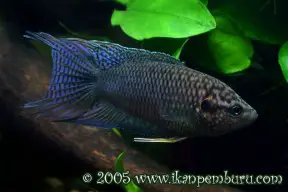Macropodus hongkongensis
Etymology
Macropodus: from the Ancient Greek μακρός (makrós), meaning ‘long’, and ποδός (podós), meaning ‘foot, leg’, in reference to the long pelvic fins in members of the genus.
hongkongensis: named for Hong Kong, type locality of the species.
Classification
Order: Perciformes Family: Osphronemidae
Distribution
In 1996 the species was known from five localities in Hong Kong, but at least one of these has been destroyed and it is now known only from Tai Po and Sai Kung districts. Additional populations have subsequently been discovered in Guangdong and Fujian provinces on the southern Chinese mainland.
Type locality is ‘China: Hong Kong: Tai Po: Sha Lo Tung’.
Habitat
Has been collected from both mountain hill streams and lowland, sometimes agricultural, environments. Apparently displays a preference for shallow habitats with dense vegetation and slow flow.
Maximum Standard Length
60 – 70 mm.
Aquarium SizeTop ↑
An aquarium with base dimensions measuring 80 ∗ 30 cm or equivalent should be the minimum considered for a single pair.
Maintenance
Can be maintained in a fully-decorated aquarium although many breeders prefer not to use a substrate for ease of maintenance.
Driftwood roots and branches can be used and placed such a way that a few shady spots are formed, while some floating or surface vegetation should be included if the aim is to breed the fish (see ‘Reproduction’).
The addition of dried leaf litter further emphasises the natural feel and as well as offering additional cover brings with it development of microbe colonies which can provide a valuable early food source for fry.
Water Conditions
Temperature: 15 – 25 °C
pH: 6.0 – 8.0
Hardness: 90 – 357 ppm
Diet
Likely to prey on insect larvae and suchlike in nature, and should be offered small live or frozen Daphnia, Artemia, white worm, grindal worm, etc., in captivity. Some high quality dried products may also be accepted.
Behaviour and CompatibilityTop ↑
Similarly-shaped fishes should be avoided, but can be maintained alongside peaceful schooling species with comparable environmental requirements.
Males are territorially aggressive, this behaviour becoming more pronounced during reproductive periods, and should not be housed together unless the aquarium is very large. It is also advisable to provide two or more females per male in order to disperse male attention.
Sexual Dimorphism
Males are larger than females and possess extended soft rays in the dorsal, anal, and caudal fins.
Reproduction
Bubble nester. Soft water with a slightly raised temperature is said to induce reproductive behaviour.
The aquarium should have the tightest-fitting cover possible (some breeders use clingfilm/plastic wrap) because the fry need access to a layer of warm, humid air, without which development of the labyrinth organ can be impaired.
The pair need not be separated prior to spawning. The male tends to construct his nest within a raft of surface vegetation, and the female(s) are usually tolerated during this period. Once the nest is complete, the male displays to potential mates using his elongated dorsal, anal, and caudal fins.
The nuptial female becomes paler in colour. Spawning normally occurs beneath the nest in an ’embrace’ typical of osphronemids, with the male wrapped around the female.
At the point of climax milt and a few eggs are released. The latter contain a globule of oil and are lighter than water, therefore they float upwards to the nest, often assisted by the male. The process is then repeated until the female is spent, with several hundred eggs typically deposited.
Post-spawning the adults can normally be left in situ. The female is normally tolerated by the male to an extent, and may even play an active role in defending the area around the nest from intruders.
Once the eggs hatch they remain in the nest until the yolk sac is fully-absorbed. When the fry begin to swim freely the male will lose interest, but the adults do not usually eat their offspring.
The require an infusoria-grade food for the first few days, after which they can accept motile foods such as microworm and Artemia nauplii. Water changes should be small and regular rather than large and intermittent.
NotesTop ↑
This species is occasionally available in the ornamental trade.
It can be distinguished from congeners by the following combination of characters: caudal-fin forked; opercular spot brown and conspicuous; dorsal surface of head with dark spots; predorsal region with 3-5 dark brown saddle-like blotches; posterior tip or margin of scales on head and body conspicuously darker than scales, but not those on head and predorsal region; distal portion of anterior soft pelvic-fin ray white; spots and bars on dorsal and caudal-fin membranes red.
Like others in the suborder Anabantoidei this species possesses an accessory breathing organ known as the labyrinth, which permits the fish to breathe atmospheric air to a certain extent. Comprising paired suprabranchial organs formed via expansion of the epibranchial (upper) section of the first gill arch and housed in a chamber above the gills, it contains many highly-vascularised, folded flaps of skin which function as a large respiratory surface. Its structure varies in complexity between species, tending to be more developed in those inhabiting harsher environments) remarking that furthers
References
- Freyhof, J. and F. Herder , 2002 - Ichthyological Exploration of Freshwaters 13(2): 147-167
Review of the paradise fishes of the genus Macropodus in Vietnam, with description of two new species from Vietnam and southern China (Perciformes: Osphronemidae). - Chan, B. P. L., D. Dudgeon and X. Chen, 2008 - Environmental Biology of Fishes 81: 367-368
Threatened fishes of the world: Macropodus hongkongensis Freyhof and Herder, 2002 (Osphronemidae). - Paepke, H-J., 1994 - Neue Brehm Bücherei 616, Westarp Wissenschaften, Magdeburg: 1-144
Die Paradiesfische. - Winstanley, T. and K. D. Clements, 2008 - Zootaxa 1908: 1-27
Morphological re-examination and taxonomy of the genus Macropodus (Perciformes: Osphronemidae).







